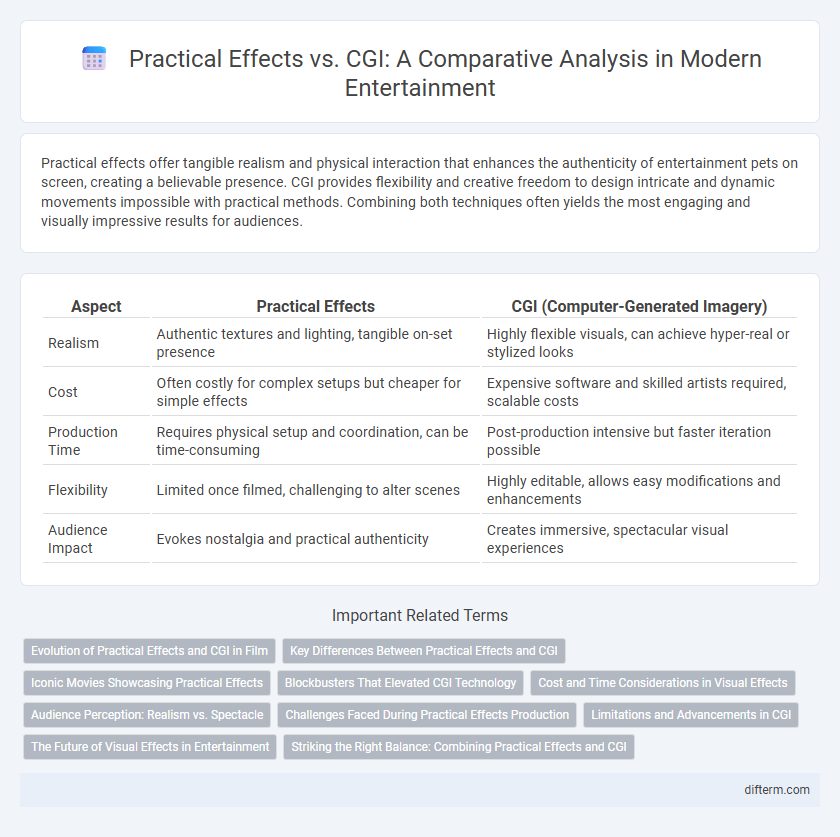Practical effects offer tangible realism and physical interaction that enhances the authenticity of entertainment pets on screen, creating a believable presence. CGI provides flexibility and creative freedom to design intricate and dynamic movements impossible with practical methods. Combining both techniques often yields the most engaging and visually impressive results for audiences.
Table of Comparison
| Aspect | Practical Effects | CGI (Computer-Generated Imagery) |
|---|---|---|
| Realism | Authentic textures and lighting, tangible on-set presence | Highly flexible visuals, can achieve hyper-real or stylized looks |
| Cost | Often costly for complex setups but cheaper for simple effects | Expensive software and skilled artists required, scalable costs |
| Production Time | Requires physical setup and coordination, can be time-consuming | Post-production intensive but faster iteration possible |
| Flexibility | Limited once filmed, challenging to alter scenes | Highly editable, allows easy modifications and enhancements |
| Audience Impact | Evokes nostalgia and practical authenticity | Creates immersive, spectacular visual experiences |
Evolution of Practical Effects and CGI in Film
The evolution of practical effects and CGI in film has transformed visual storytelling, blending handcrafted techniques with digital innovation. Classic practical effects like miniatures, animatronics, and prosthetics laid the groundwork for immersive worlds, while contemporary CGI offers limitless possibilities for creating complex, photo-realistic environments and characters. Modern filmmakers often integrate both methods to enhance authenticity and spectacle, preserving the tactile realism of practical effects alongside the expansive creativity of computer-generated imagery.
Key Differences Between Practical Effects and CGI
Practical effects involve physical, tangible elements such as puppets, animatronics, makeup, and miniatures, providing a sense of realism through real-world textures and lighting. CGI (Computer-Generated Imagery) relies on digital animation and visual effects created via software like Autodesk Maya or Adobe After Effects, allowing for more flexible and complex visual creations that are often impossible to produce physically. The key differences lie in practical effects offering organic interaction and immediate presence on set, while CGI provides limitless creative potential and post-production adjustments.
Iconic Movies Showcasing Practical Effects
Iconic movies like "Jurassic Park" and "The Dark Knight" demonstrate the enduring appeal of practical effects, showcasing lifelike animatronics and intricate stunt work that create immersive, tangible experiences. Practical effects deliver authenticity by grounding fantastical elements in reality, which enhances audience emotional connection and suspension of disbelief. In contrast to CGI, these tactile techniques age gracefully, maintaining their impact in cinematic history and inspiring modern filmmakers.
Blockbusters That Elevated CGI Technology
Blockbusters such as "Avatar," "The Avengers," and "Jurassic World" revolutionized CGI technology by integrating hyper-realistic digital environments and creatures that surpassed traditional practical effects in scale and detail. These films leveraged cutting-edge motion capture, advanced rendering techniques, and AI-driven animations to create immersive visual experiences that practical effects alone could not achieve. The continuous evolution of CGI in these blockbusters sets new standards for realism and storytelling in entertainment.
Cost and Time Considerations in Visual Effects
Practical effects often require higher initial investment in materials and specialized labor but can reduce post-production time, making them cost-effective for intricate, tangible scenes. CGI demands substantial computing resources and skilled artists, potentially increasing both budget and production schedule, especially for complex animations. Balancing these factors depends on project scale, desired realism, and available technology, with hybrid approaches becoming increasingly common to optimize cost and time efficiency.
Audience Perception: Realism vs. Spectacle
Audience perception often leans toward practical effects for their tangible realism and authentic textures, enhancing immersion in a film's world. CGI, however, excels at delivering spectacular visuals that push creative boundaries beyond physical limitations, captivating viewers with imaginative scenarios. Balancing practical effects with CGI creates a dynamic viewing experience that satisfies both the desire for authenticity and awe-inspiring spectacle.
Challenges Faced During Practical Effects Production
Practical effects production in entertainment faces challenges such as high costs, time-consuming setups, and limitations in achieving complex visuals compared to CGI. Physical materials and mechanical devices require extensive maintenance and precise coordination among crew members to ensure safety and effectiveness. Weather conditions and environmental factors can further complicate outdoor shoots involving practical effects.
Limitations and Advancements in CGI
Advancements in CGI have significantly enhanced the realism and scope of visual storytelling, allowing intricate environments and complex characters that were previously impossible with practical effects alone. However, CGI still faces limitations such as high production costs, the uncanny valley effect, and challenges in replicating natural physics and subtle human expressions convincingly. Practical effects provide tangible interactions and authenticity that CGI struggles to match, making a hybrid approach increasingly popular in modern entertainment productions.
The Future of Visual Effects in Entertainment
Practical effects offer tangible realism and physical presence that CGI often struggles to replicate, enhancing audience immersion in entertainment. CGI enables limitless creativity and dynamic visual storytelling through advanced computer-generated imagery, continually evolving with AI and machine learning integration. The future of visual effects lies in a hybrid approach, combining practical effects' authenticity with CGI's versatility to create more believable and innovative experiences.
Striking the Right Balance: Combining Practical Effects and CGI
Striking the right balance between practical effects and CGI enhances realism while pushing creative boundaries in entertainment. Practical effects provide tactile authenticity and tangible detail, essential for immersive viewer experiences, whereas CGI offers limitless scalability and flexibility for complex visuals. Integrating both techniques optimizes production value, ensuring visually stunning scenes that captivate audiences without compromising believability.
practical effects vs CGI Infographic

 difterm.com
difterm.com